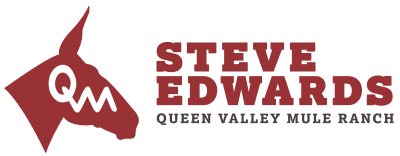Halter Training a Mule
Steve Edwards: So, I’m gonna come up, and I’m gonna kind of pet on him. Now, this rope that I have, it’s got a smell to it. It’s got wax, it’s a wax-coated. So, I’m going to, I’m gonna put it over his head, but I’m gonna come up here like this and kind of pet on him. Scratch on him a little bit and kinda let him see. He’s kind of bracing a little bit, he’s worried about it. So, I’m gonna come on up and pet on him, kinda go nice and slow. There, like that. And pet on him as I’m going at it, so he doesn’t get worried about it, but I can feel in my hands he’s bracing me, kind of pushing at me a little bit. So I’ll go ahead and pull that on up.
Now, this is a wax-coated rope, it’s two-strand, so it’s fairly soft, but yet, I can still … The idea of the wax is so when I put this on him, it doesn’t move up and down the face a lot. It used to be I told everybody, “Take you an old lariat rope, take one strand out of it, and you got yourself a rope.” But the waxing was what’s important.
So, we’re gonna go right to left, and you see he’s a little worried about his nose, not too bad. Come around again, right to left. Notice, I put the coils down on the ground here, because you can get yourself hung up with those coils. And then, I pull up on the first one, and I push on the second one. And see, he’s a little worried about that, so I’ll come back, I’ll put my left hand on his nose, and I’ll rub on him a little bit, and if he goes and pulls his head up, I’m gonna squeeze his nose. So, I’m gonna get his head to come down, come around the right ear first, left ear second. Why do I do the right ear first? If I do the right ear first, I tend to bring him to me. If I do the left ear first, I tend to push him away from me.
Now, I can feel this mule’s got a lot of stiffness. Like right here, lot of stiffness. So, I’m gonna work on this mule a little bit. So that, I’m gonna work on softness. I’m gonna put my right hand up on the poll, my left hand here, and I’m taking my middle finger, and when he pushes against me, I’m gonna push right in here. So, I’m using this finger, pushing right in here, making it uncomfortable for him. There. So, I want the softness.
So now, I pick up on the lead rope. Myself, I like to see my clients just use loops, because they’re not used to using coils and getting themselves hung up. So, I’m gonna pick the mule up and come over here in the shade a little bit.
Now, the come-a-long hitch comes over the poll, and there’s a notch right here you can kind of feel, there’s a natural notch right in this area. You can feel the back of the skull coming up right here. So this rope, you want to always keep it right in this area, and then you want it two fingers above the nostril.
Now, this is going to communicate to the nose, underneath the chin, and on the poll. So, I communicate to all three places that need to be communicated with. Not like a chain where it’s only at the nose, the top, or bottom, okay? So, one of the things I’m going to do is kind of pick up on it, and kind of pick, and just kind of touch the mule a little bit like this. Good. Get a foot movement, and then come over here. Pick it up. Get a foot movement. Front foot, very good. Now, I’m going to kind of back up a little bit. Bracing me right there. Watch my hand. See how it rolls? Asking, telling, demanding. All right, now let’s go back to the ask. See him brace? See him brace? Ask, tell… I didn’t have to go to a demand.
So, I’ll come back forward. See him bracing me right there? Ask. Tell. Demand. Demand. Okay. Yeah, you betcha.
Now, will they lose hair on their nose? Oh, yeah. Will you be able to see where the rope was. Oh, yeah. But see, right now, she’s using all five major neck muscles; the one run along the crest, the one down through the center, the one along the esophagus, and these two here, plus the throat latch against us. See that muscle right there? That’s a pretty tight throat latch for being able to be pulled on, okay? So, I’m gonna ask her to back up again. Ask. Tell. Good. Ask. Aw, better. Ask. Oh, yes. Man, I don’t like that tell and demand stuff, so ask here to come forward. Asking, here. Telling, here. Demanding. See her brace against me. Now-
Women: But you’re facing her. That’s the thing that’s confusing to me, is you’re facing her when you’re doing that.
Steve Edwards: Only because I’m building a foundation with her head first. Later on, I’ll change that. Right now, she needs to understand to respect the halter. “Don’t pay attention to me, listen to the halter.” I’m halter training, okay?
So, now, I’m gonna ask. Good for you. Now, I’m gonna ask. Good for you. So, I’m halter training. I’m not the monster yet, but I’m getting ready to be. Okay, so now pick it up again, asking. Good. Asking. Good. Now, backing up. Good. Good. Good for you. See the difference? Asking, telling, demanding makes sense to them because it is the way they talk, the way they understand, okay? So now, we’ll go back, and I’ll ask.
So, what I’m doing is halter training. All right? This is all halter training.
- Posted in: Everything, Halter Training, Videos
- Tagged: Everything, Halter Training, Videos



1 thought on “Halter Training a Mule”
80-ish and sunny here in Salt Lake City, Utah. Thanks for the advice on the gelding brain surgery as soon as they drop. saved me a catastrophe. New question : my 2-3 year old female Georgia sugar mule is too scared to walk on even the shallowest water puddles, or even on to wet pavement . where did either I or her go wrong?